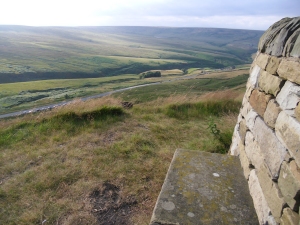This stanza stone is hidden on Pule Hill, Marsden. Marsden is where Simon Armitage grew up. He is a poet I first came across in the AQA GCSE anthology ‘Moon on the Tides’, with ‘Harmonium’ and ‘The Manhunt’, and saw relatively recently reading at the Southbank Centre for National Poetry Day 2013. His collection which I am most keen to read is ‘CloudCuckooLand’.
During my week in Marsden, I heard some of the local tales and legends that make up part of its history. One of the most important of these stories is the story of the cuckoo: people realised that as the cuckoo migrated into the town, it brought good weather. They decided, then, to keep the cuckoo enclosed in a tower, and built it so it was tall enough, they thought, to stop the cuckoo from leaving. Their logic was flawed; they didn’t put a roof on it, so the cuckoo flew out. This story is celebrated every year with ‘Cuckoo Day’, when a giant cuckoo (not a real one) is taken down the main street of Marsden.
To Armitage, who studied geography at Portsmouth University, place and environment must be very important to his work. The stanza stones respond to the moors, but then become part of the landscape which they reflect. The Snow Stone, in particular, has gradually been taken over by lichen, and the words themselves are now a fluorescent green.
The poetry seat on Pule Hill encourages you to ponder the environment yourself, and get down some of your own poems.
Here is where young poets have used the moors as material for their own poems, and Simon Armitage and Pip Hall write briefly about the project.
As always, Ted Hughes manages to creep into these posts. Here are a couple of clips of Simon Armitage on Ted Hughes:


